Evaluation and Expected Changes of Summer Precipitation at Convection Permitting Scale with COSMO-CLM over Alpine Space
Abstract
1. Introduction
- (i)
- Investigate behaviors and footprints yielded by a convection-parameterizing climate simulation and a convection-resolving one for summer precipitation at daily and hourly scales;
- (ii)
- Investigate potential changes in summer precipitation regimes, expected for the end of the century, resulting from the ongoing climate change;
- (iii)
- Prove limitations and benefits returned by a spatial and temporal refinement of CP-RCM.
2. Methods
2.1. The COSMO-CLM Model
2.2. Simulations Set-Up
- EUR-11: it is characterized by a spatial resolution of 0.11° (~12 km) covering the Euro-CORDEX domain (48.50° W–69.86° E; 20.15°–74.01° N) leading to a computational domain with 450 × 438 grid points and 40 vertical levels. The time step for integration is set equal to 75 s. Here the convection is standard parameterized based on the Tiedtke scheme;
- ALP-3: it is characterized by a spatial resolution of 0.0275° (~3 km) covering an extended Alpine domain from central Italy to northern Germany (4.56° W–18.30° E; 37.50°–52.63° N) leading to a computational domain with 522 × 490 grid points and 50 vertical levels. The time step for integration is set equal to 25 s. The lateral boundary conditions for ALP-3 come from the COSMO-CLM model at 12 km resolution (EUR-11). Here the convection is explicitly solved and TERRA-URB parameterization, for the representation of the urban dynamics, is also used.
2.3. Observations
- EURO4M-APGD: it is a daily precipitation available at a horizontal resolution of 5 km over the Alpine region from 1971–2008; such a dataset is based on daily rain gauge station data, and is presented in [46];
- GRIPHO: it is an hourly gridded precipitation dataset, available over Italy at a horizontal resolution of 3 km [47]; such a dataset is based on rain gauge measurements and is available for the period 2001–2016;
2.4. Climate Indicators and Statistical Tools
3. Results
3.1. Precipitation Evaluation at Daily Scale (2000–2009)
3.2. Precipitation Evaluation at Hourly Scale (2001–2005)
3.3. Future Precipitation Projections (2090–2099 vs. 1996–2005)
4. Discussion and Conclusions
Author Contributions
Funding
Data Availability Statement
Acknowledgments
Conflicts of Interest
References
- IPCC. Summary for policy makers. In Climate Change 2013: The Physical Science Basis. Contribution of Working Group I to the Fifth Assessment Report of the Intergovernmental Panel on Climate Change; Stocker, T.F., Qin, D., Plattner, G.-K., Tignor, M., Allen, S.K., Boschung, J., Nauels, A., Xia, Y., Bex, V., Midgley, P.M., Eds.; Cambridge University Press: Cambridge, UK; New York, NY, USA, 2013. [Google Scholar]
- Allen, M.R.; Ingram, W. Constraints on future changes in climate and the hydrologic cycle. Nature 2002, 419, 224–232. [Google Scholar] [CrossRef] [PubMed]
- Padulano, R.; Reder, A.; Rianna, G. An ensemble approach for the analysis of extreme rainfall under climate change in Naples (Italy). Hydrol. Process. 2019, 33, 2020–2036. [Google Scholar] [CrossRef]
- Rianna, G.; Reder, A.; Pagano, L.; Mercogliano, P. Assessing future variations in landslide occurrence due to climate changes: Insights from an Italian test case. CNRIG 2019 Geotech. Res. Land Prot. Dev. 2020, 255–264. [Google Scholar] [CrossRef]
- Maraun, D.; Widmann, M. Statistical Downscaling and Bias Correction for Climate Research; Cambridge University Press: Cambridge, UK, 2018. [Google Scholar]
- Ban, N.; Schmidli, J.; Schär, C. Evaluation of the new convective-resolving regional climate modelling approach in decade-long simulations. J. Geophys. Res. Atmos. 2014, 119, 7889–7907. [Google Scholar] [CrossRef]
- Kendon, E.J.; Roberts, N.M.; Senior, C.A.; Roberts, M.J. Realism of rainfall in a very high-resolution regional climate model. J. Clim. 2012, 25, 5791. [Google Scholar] [CrossRef]
- Kendon, E.J.; Roberts, N.M.; Fowler, H.J.; Roberts, M.J.; Chan, S.C.; Senior, C.A. Heavier summer downpours with climate change revealed by weather forecast resolution model. Nat. Clim. Chang. 2014, 4, 570–576. [Google Scholar] [CrossRef]
- Leutwyler, D.; Luthi, D.; Ban, N.; Fuhrer, O.; Schar, C. Evaluation of the convection-resolving climate modeling approach on continental scales. J. Geophys. Res. Atmos. 2017, 122, 5237–5258. [Google Scholar] [CrossRef]
- Berthou, S.; Kendon, E.J.; Chan, S.C.; Ban, N.; Leutwyler, D.; Schär, C.; Fosser, G. Pan-European climate at convection-permitting scale: A model intercomparison study. Clim. Dyn. 2018, 5, 1–25. [Google Scholar] [CrossRef]
- Fumiere, Q.; Deque, M.; Nuissier, O.; Somot, S.; Alias, A.; Caillaud, C.; Laurantin, O.; Seity, Y. Extreme rainfall in mediterranean France during the fall: Added value of the CNRM-AROME Convection- permitting regional climate model. Clim. Dyn. 2019. [Google Scholar] [CrossRef]
- Pichelli, E.; Coppola, E.; Ban, N.; Giorgi, F.; Stocchi, P.; Antoinette, A.; Danijel, B.; Segolene, B.; Cecile, C.; Rita, M.C. Precipitation projections of the first multi-model ensemble of regional climate simulations at convection permitting scale. EGU Gen. Assem. 2020. [Google Scholar] [CrossRef]
- Ban, N.; Brisson, E.; Caillaud, C.; Coppola, E.; Pichelli, E.; Sobolowski, S.; Adinolfi, M.; Ahrens, B.; Alias, A.; Anders, I.; et al. The first multi-model ensemble of regional climate simulations at kilometer-scale resolution, Part I: Evaluation of precipitation. EGU Gen. Assem. 2020. [Google Scholar] [CrossRef]
- White, B.A.; Buchanan, A.M.; Birch, C.E.; Stier, P.; Pearson, K.J. Quantifying the effects of horizontal grid length and parameterized convection on the degree of convective organization using a metric of the potential for convective interaction. J. Atmos. Sci. 2018, 75, 425–450. [Google Scholar] [CrossRef]
- Kendon, E.J.; Ban, N.; Roberts, N.M.; Fowler, H.J.; Roberts, M.J.; Chan, S.C.; Evans, J.P.; Fosser, G.; Wilkinson, J.M. Do convection-permitting regional climate models improve projections of future precipitation change? Bull. Am. Meteorol. Soc. 2017, 98, 79–93. [Google Scholar] [CrossRef]
- Prein, A.F.; Langhans, W.; Fosser, G.; Ferrone, A.; Ban, N.; Goergen, K.; Keller, M.; Tölle, M.; Gutjahr, O.; Feser, F.; et al. A review on regional convection-permitting climate modeling: Demonstrations, prospects, and challenges. Rev. Geophys. 2015, 53, 323–361. [Google Scholar] [CrossRef] [PubMed]
- Fosser, G.; Khodayar, S.; Berg, P. Benefit of convection permitting climate model simulations in the representation of convective precipitation. Clim. Dyn. 2015, 44, 45–60. [Google Scholar] [CrossRef]
- Coppola, E.; Sobolowski, S.; Pichelli, E.; Raaele, F.; Ahrens, B.; Anders, I.; Ban, N.; Bastin, S.; Belda, M.; Belusic, D.; et al. A first-of-its-kind multi-model convection permitting ensemble for investigating convective phenomena over europe and the mediterranean. Clim. Dyn. 2019, 1–32. [Google Scholar] [CrossRef]
- Ban, N.; Schmidli, J.; Schär, C. Heavy precipitation in a changing climate: Does short-term summer precipitation increase faster? Geophys. Res. Lett. 2015, 42, 1165–1172. [Google Scholar] [CrossRef]
- Chan, S.C.; Kendon, E.J.; Fowler, H.J.; Blenkinsop, S.; Ferro, C.A.T.; Stephenson, D.B. Does increasing the spatial resolution of a regional climate model improve the simulated daily precipitation? Clim. Dyn. 2013, 41, 1475–1495. [Google Scholar] [CrossRef]
- Rasmussen, R.; Liu, C.; Ikeda, K.; Gochis, D.; Yates, D.; Chen, F.; Tewari, M.; Barlage, M.; Dudhia, J.; Yu, W.; et al. High-resolution coupled climate runoff simulations of seasonal snowfall over colorado: A process study of current and warmer climate. J. Clim. 2011, 24, 3015–3048. [Google Scholar] [CrossRef]
- Montesarchio, M.; Zollo, A.L.; Bucchignani, E.; Mercogliano, P.; Castellari, S. Performance evaluation of high-resolution regional climate simulations in the Alpine space and analysis of extreme events. J. Geophys. Res. Atmos. 2014, 119, 3222–3237. [Google Scholar] [CrossRef]
- Reder, A.; Raffa, M.; Montesarchio, M.; Mercogliano, P. Performance evaluation of regional climate model simulations at different spatial and temporal scales over the complex orography area of the Alpine region. Nat. Hazards 2020, 102, 151–177. [Google Scholar] [CrossRef]
- Bucchignani, E.; Montesarchio, M.; Zollo, A.L.; Mercogliano, P. High-resolution climate simulations with COSMO-CLM over Italy: Performance evaluation and climate projections for the 21st century. Int. J. Climatol. 2016, 36, 735–756. [Google Scholar] [CrossRef]
- Rockel, B.; Will, A.; Hence, A. The regional climate model COSMO-CLM (CCLM). Meteorol. Z. 2008, 17, 347–348. [Google Scholar] [CrossRef]
- Förstner, J.; Doms, G. Runge–Kutta time integration and high-order spatial discretization of advection—A new dynamical core for the LMK: Model development and application. COSMO Newsl. 2004, 4, 168–176. [Google Scholar]
- Baldauf, M.; Seifert, A.; Förstner, J.; Majewski, D.; Raschendorfer, M.; Reinhardt, T. Operational convective-scale numerical weather prediction with the COSMO model: Description and sensitivities. Mon. Weather Rev. 2011, 139, 3887–3905. [Google Scholar] [CrossRef]
- Wicker, L.J.; Skamarock, W.C. Time-splitting methods for elastic models using forward time schemes. Mon. Weather Rev. 2002, 130, 2088–2097. [Google Scholar] [CrossRef]
- Reinhardt, T.; Seifert, A. A three-category ice-scheme for LMK. COSMO Newsl. 2006, 6, 115–120. [Google Scholar]
- Schlemmer, L.; Schär, C.; Lüthi, D.; Strebel, L. A groundwater and runoff formulation for weather and climate models. J. Adv. Model. Earth Syst. 2018, 10, 1809–1832. [Google Scholar] [CrossRef]
- Wouters, H.; Demuzere, M.; De Ridder, K.; van Lipzig, N.P.M. The impact of impervious water-storage parametrization on urban climate modelling. Urban Clim. 2015, 11, 24–50. [Google Scholar] [CrossRef]
- Wouters, H.; Demuzere, M.; Blahak, U.; Fortuniak, K.; Maiheu, B.; Camps, J.; Tielemans, D.; van Lipzig, N.P.M. The efficient urban canopy dependency parametrization (SURY) v1.0 for atmospheric modelling: Description and application with the COSMO-CLM model for a Belgian summer. Geosci. Model Dev. 2016, 9, 3027–3054. [Google Scholar] [CrossRef]
- De Ridder, K.; Bertrand, C.; Casanova, G.; Lefebvre, W. Exploring a new method for the retrieval of urban thermo physical properties using thermal infrared remote sensing and deterministic modelling. J. Geophys. Res. 2012, 117, 1–14. [Google Scholar]
- Demuzere, M.; De Ridder, K.; van Lipzig, N.P.M. Modeling the energy balance in Marseille: Sensitivity to roughness length parametrizations and thermal admittance. J. Geophys. Res. 2008, 113, 1–19. [Google Scholar] [CrossRef]
- Schulz, J.-P.; Vogel, G.; Becker, C.; Kothe, S.; Rummel, U.; Ahrens, B. Evaluation of the ground heat flux simulated by a multi-layer land surface scheme using high quality observations at grass land and bare soil. Meteorol. Z. 2016. [Google Scholar] [CrossRef]
- Ritter, B.; Geleyn, J.F. A comprehensive radiation scheme for numerical weather prediction models with potential applications in climate simulations. Mon. Weather Rev. 1992, 120, 303–325. [Google Scholar] [CrossRef]
- Vergara-Temprado, J.; Ban, N.; Panosetti, D.; Schlemmer, L.; Schär, C. Climate models permit convection at much coarser resolutions than previously considered. J. Clim. 2020, 33, 1915–1933. [Google Scholar] [CrossRef]
- Mellor, G.L.; Yamada, T. Development of a turbulence closure model for geophysical fluid problems. Rev. Geophys. 1982, 20, 851–875. [Google Scholar] [CrossRef]
- Raschendorfer, M. The new turbulence parameterization of LM. COSMO Newsl. 2001, 1, 89–97. [Google Scholar]
- Tiedtke, M. A comprehensive mass flux scheme for cumulus parameterization in large-scale models. Mon. Weather Rev. 1989, 117, 1779–1800. [Google Scholar] [CrossRef]
- Brisson, E.; Demuzere, M.; Van Lipzig, N. Modelling strategies for performing convection-permitting climate simulations. Meteorol. Z. 2015, 25, 149–163. [Google Scholar] [CrossRef]
- Dee, D.P.; Uppala, S.M.; Simmons, A.J.; Berrisford, P.; Poli, P.; Kobayashi, S.; Andrae, U.; Balmaseda, M.A.; Balsamo, G.; Bauer, P.; et al. The ERA-Interim reanalysis: Configuration and performance of the data assimilation system. Q. J. R. Meteorol. Soc. 2011, 137, 553–597. [Google Scholar] [CrossRef]
- Hazeleger, W.; Severijns, C.; Semmler, T.; Ştefănescu, S.; Yang, S.; Wang, X.; Wyser, K.; Dutra, E.; Baldasano, J.M.; Bintanja, R.; et al. EC-Earth: A seamless earth-system prediction approach in action. Bull. Am. Meteorol. Soc. 2010, 91, 1357–1364. [Google Scholar] [CrossRef]
- Moss, R.H.; Edmonds, J.A.; Hibbard, K.A.; Manning, M.R.; Rose, S.K.; Van Vuuren, D.P.; Meehl, G.A. The next generation of scenarios for climate change research and assessment. Nature 2010, 463, 747. [Google Scholar] [CrossRef] [PubMed]
- Joint Research Centre. Global Land Cover 2000 Database, European Commission; Joint Research Centre: Ispra, Italy, 2003. [Google Scholar]
- Isotta, F.; Frei, C.; Weilguni, V.; Tadic, M.P.; Lassegues, P.; Rudolf, B.; Pavan, V.; Cacciamani, C.; Antolini, G.; Ratto, S.M.; et al. The climate of daily precipitation in the Alps: Development and analysis of a high-resolution grid dataset from pan-Alpine rain-gauge data. Int. J. Climatol. 2014, 34, 1657–1675. [Google Scholar] [CrossRef]
- Fantini, A. Climate Change Impact on ood Hazard over Italy. Ph.D. Thesis, Universita degli Studi di Trieste, Trieste, Italy, 2019. [Google Scholar]
- Tabary, P.; Dupuy, P.; L’Hena, G.; Gueguen, C.; Moulin, L.; Laurantin, O.; Merlier, C.; Soubeyroux, J.M. A 10-Year (1997–2006) Reanalysis of Quantitative Precipitation Estimation over France: Methodology and First Results; IAHS: Wallingford, UK, 2012; Volume 351, pp. 255–260. [Google Scholar]
- Prein, A.F.; Gobiet, A. Impacts of uncertainties in European gridded precipitation observations on regional climate analysis. Int. J. Climatol. 2017, 37, 305–327. [Google Scholar] [CrossRef] [PubMed]
- Schär, C.; Ban, N.; Fischer, E.M.; Rajczak, J.; Schmidli, J.; Frei, C.; O’Gorman, P.A. Percentile indices for assessing changes in heavy precipitation events. Clim. Chang. 2016, 137, 201–216. [Google Scholar] [CrossRef]
- Ban, N.; Rajczak, J.; Schmidli, J.; Schär, C. Analysis of Alpine precipitation extremes using generalized extreme value theory in convection-resolving climate simulations. Clim. Dyn. 2020, 551, 61–75. [Google Scholar] [CrossRef]
- McGill, R.; Tukey, J.W.; Larsen, W.A. Variations of box plots. Am. Stat. 1978, 32, 12–16. [Google Scholar]
- Watterson, I.G.; Dix, M.R. Simulated changes due to global warming in daily precipitation means and extremes and their interpretation using the gamma distribution. J. Geophys. Res. 2003, 108, 4397. [Google Scholar] [CrossRef]
- Watterson, I.G. Simulated changes due to global warming in the variability of precipitation and their interpretation using a gamma distributed stochastic model. Adv. Water Resour. 2005, 28, 1368–1381. [Google Scholar] [CrossRef]
- Elshamy, M.E.; Seierstad, I.A.; Sorteberg, A. Impacts of climate change on Blue Nile flows using bias-corrected GCM scenarios. Hydrol. Earth Syst. Sci. 2009, 13, 551–565. [Google Scholar] [CrossRef]
- Piani, C.; Haerter, J.O.; Coppola, E. Statistical bias correction for daily precipitation in regional climate models over Europe. Theor. Appl. Climatol. 2010, 99, 187–192. [Google Scholar] [CrossRef]
- Anderson, T.W.; Darling, D.A. A test of goodness of fit. J. Am. Stat. Assoc. 1954, 49, 765–769. [Google Scholar] [CrossRef]
- Soares, P.M.; Cardoso, R.M. A simple method to assess the added value using high-resolution climate distributions: Application to the EURO-CORDEX daily precipitation. Int. J. Climatol. 2018, 38, 1484–1498. [Google Scholar] [CrossRef]
- Christensen, J.H.; Hewitson, B.; Busuioc, A.; Chen, A.; Gao, X.; Held, I.; Jones, R.; Kolli, R.K.; Kwon, W.-T.; Laprise, R.; et al. Regional climate projections. In Climate Change (2007): The Physical Science Basis. Contribution of Working Group I to the Fourth Assessment Report of the Intergovernmental Panel on Climate Change; Solomon, S., Qin, D., Manning, M., Chen, Z., Marquis, M., Averyt, K.B., Tignor, M., Miller, H.L., Eds.; Cambridge University Press: Cambridge, UK, 2007. [Google Scholar]
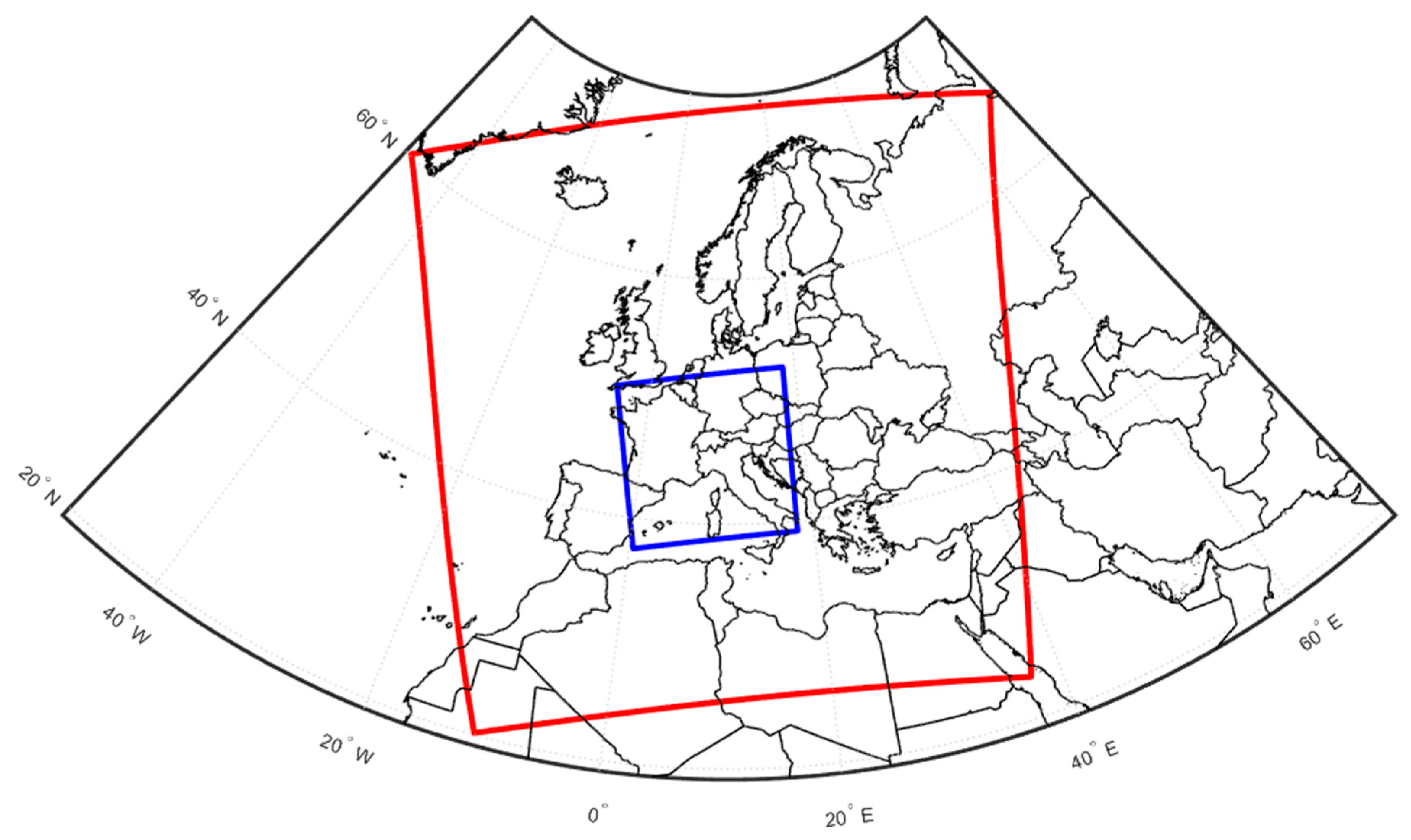
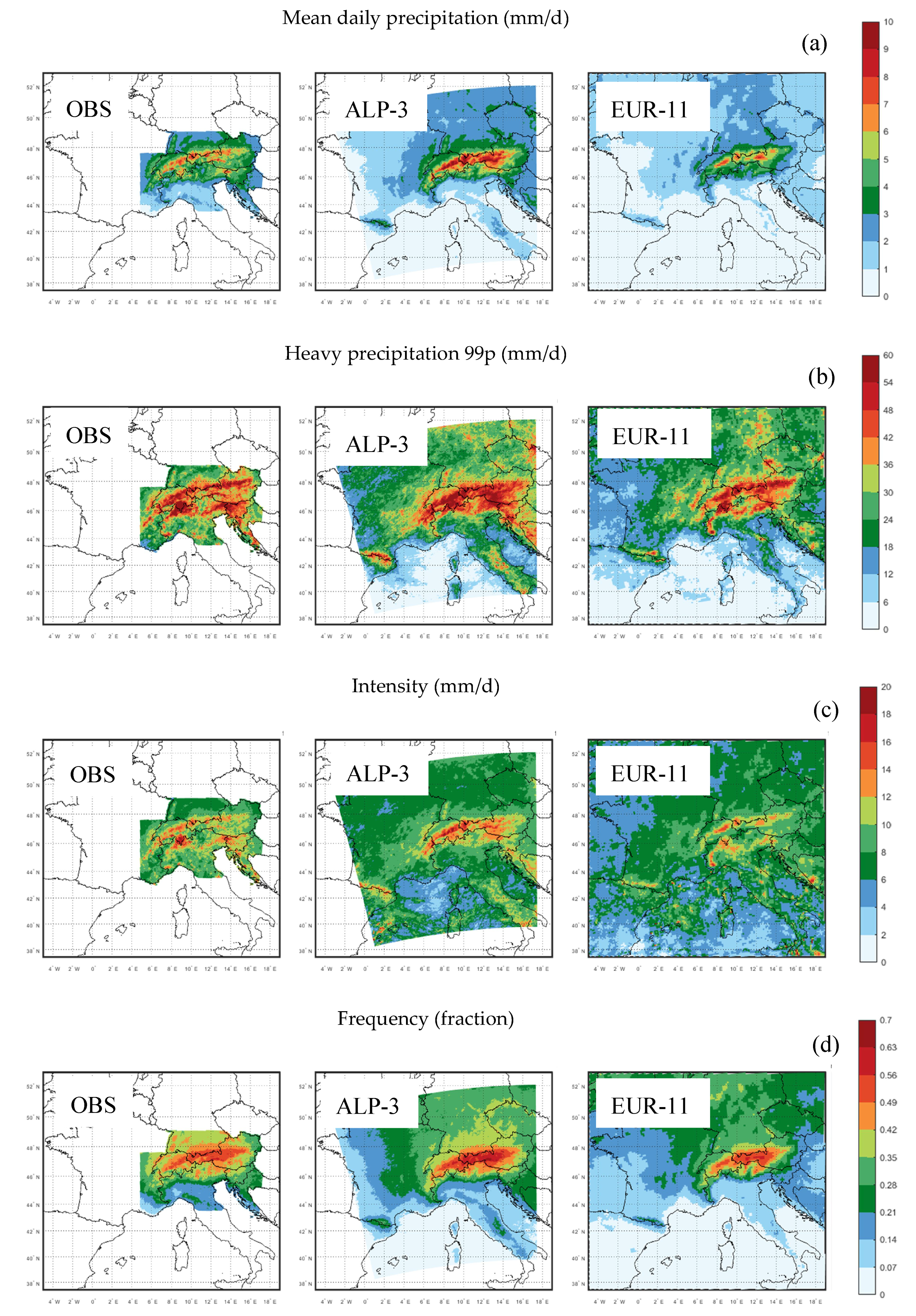
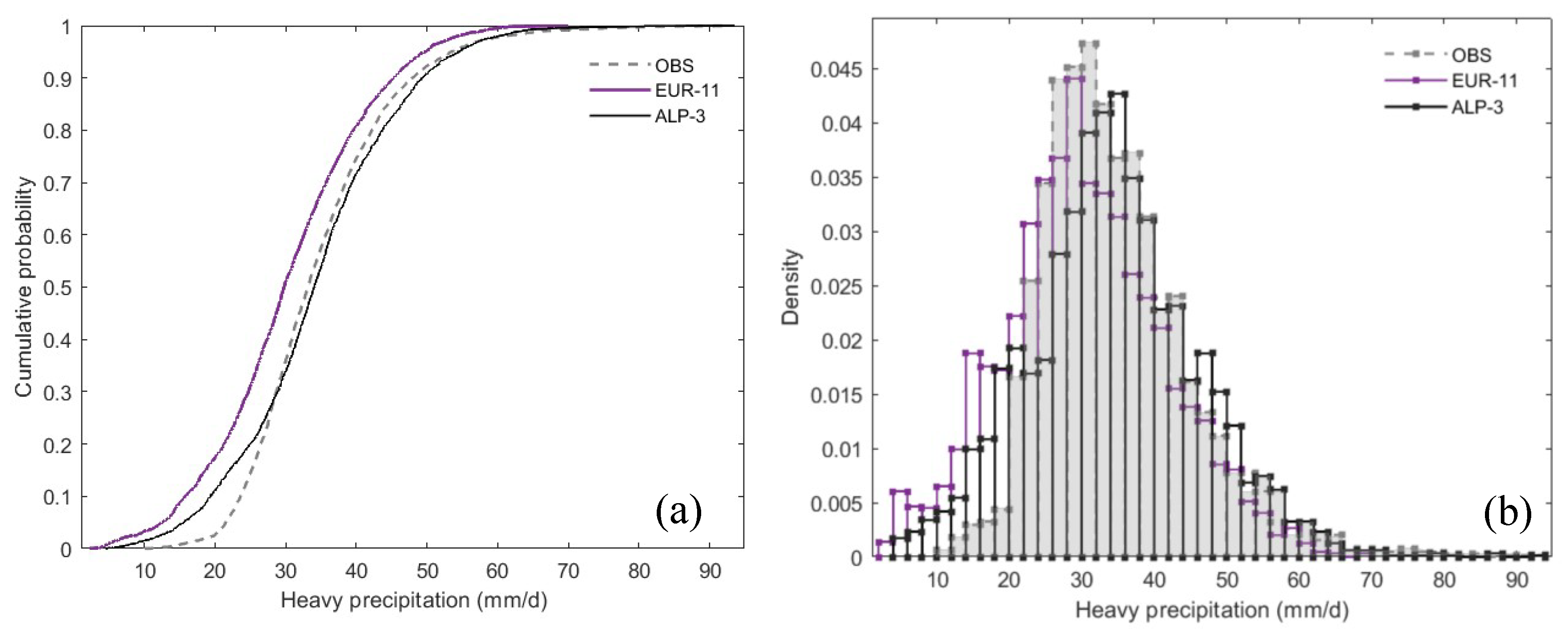
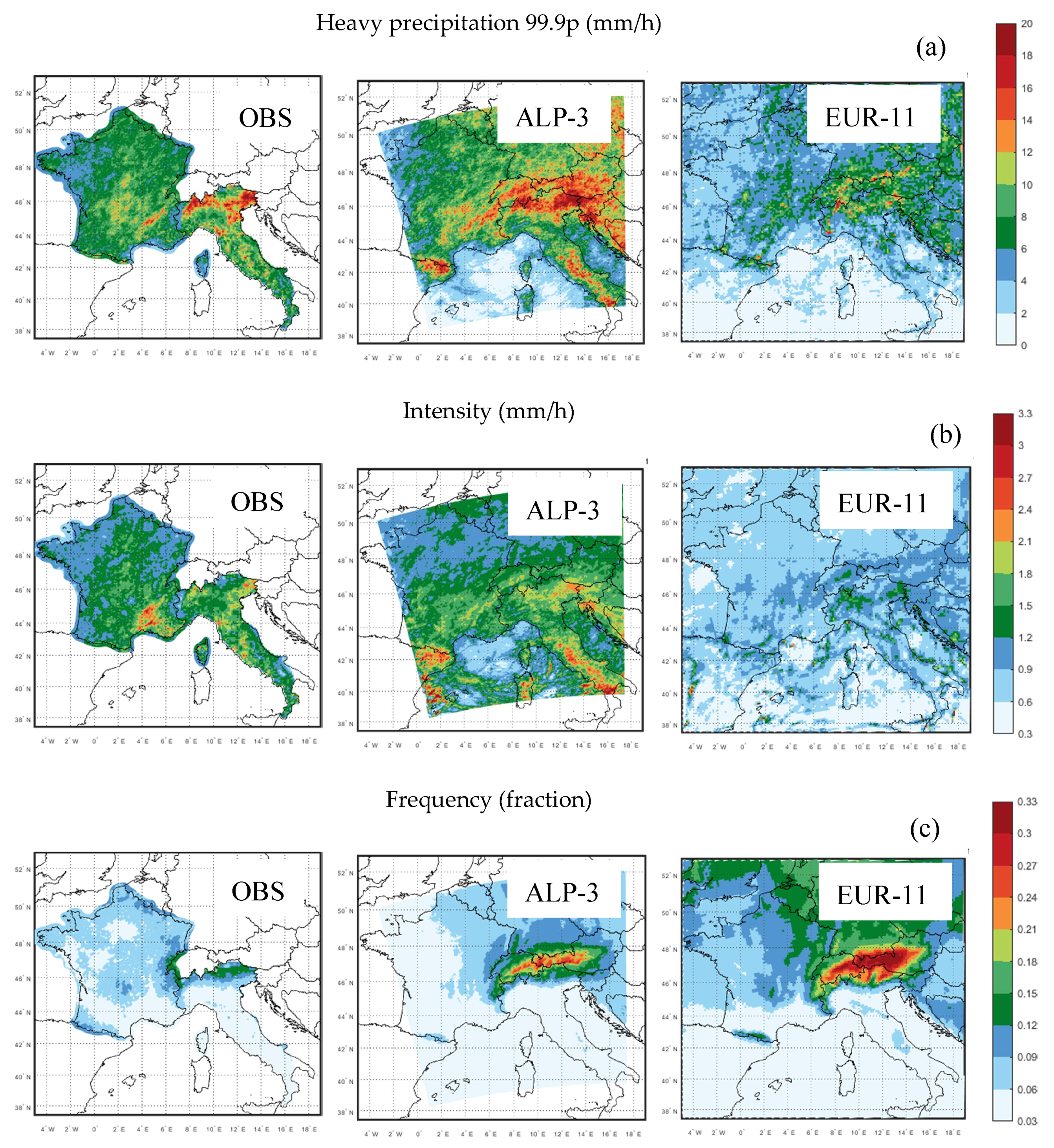
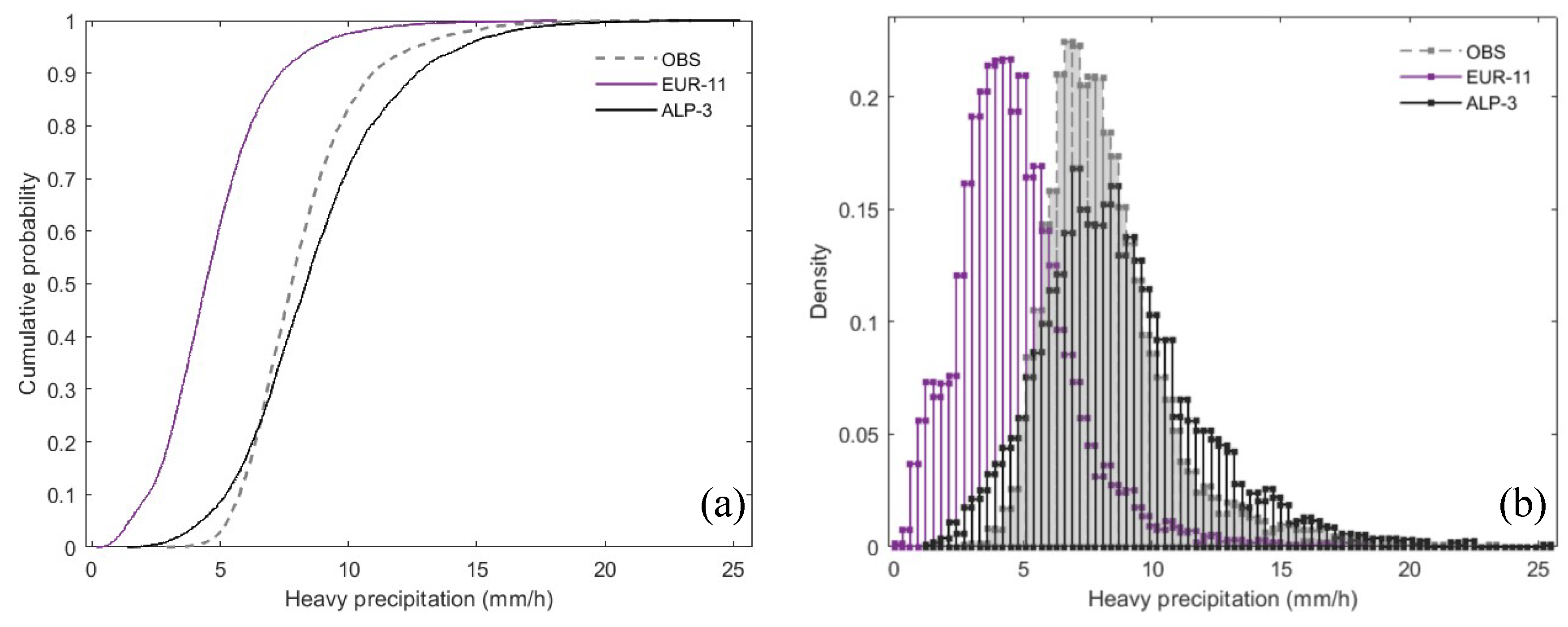
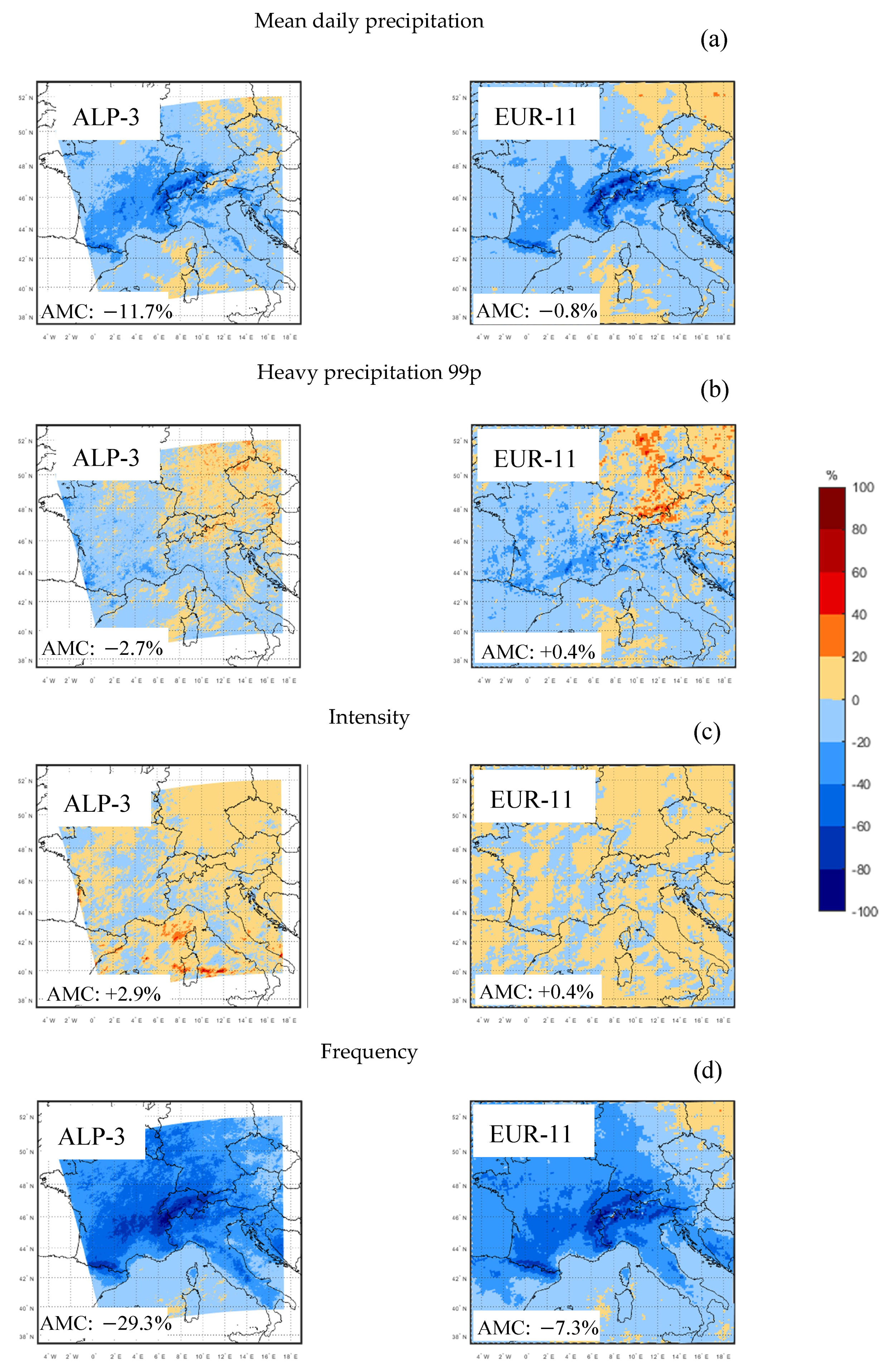
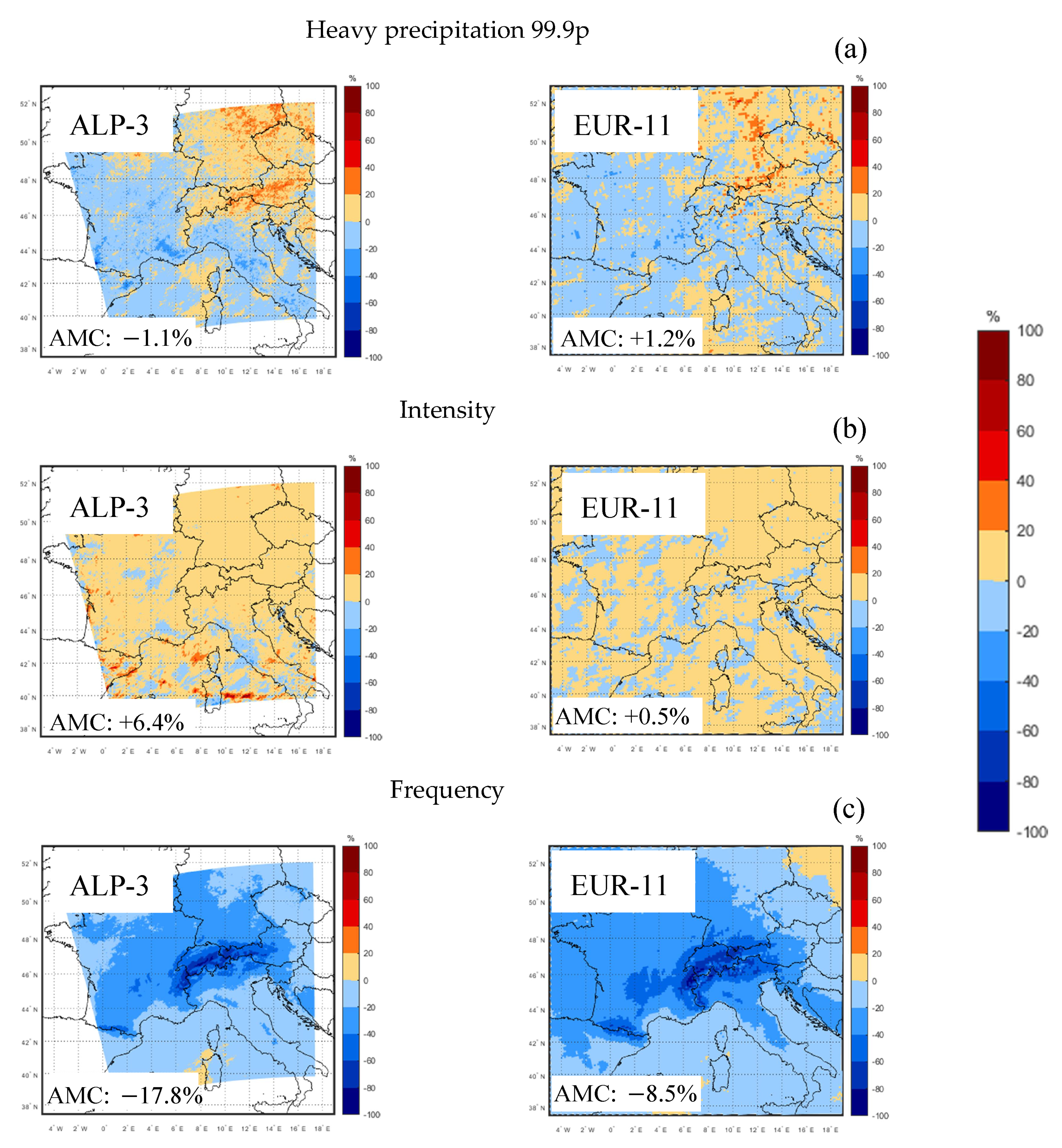
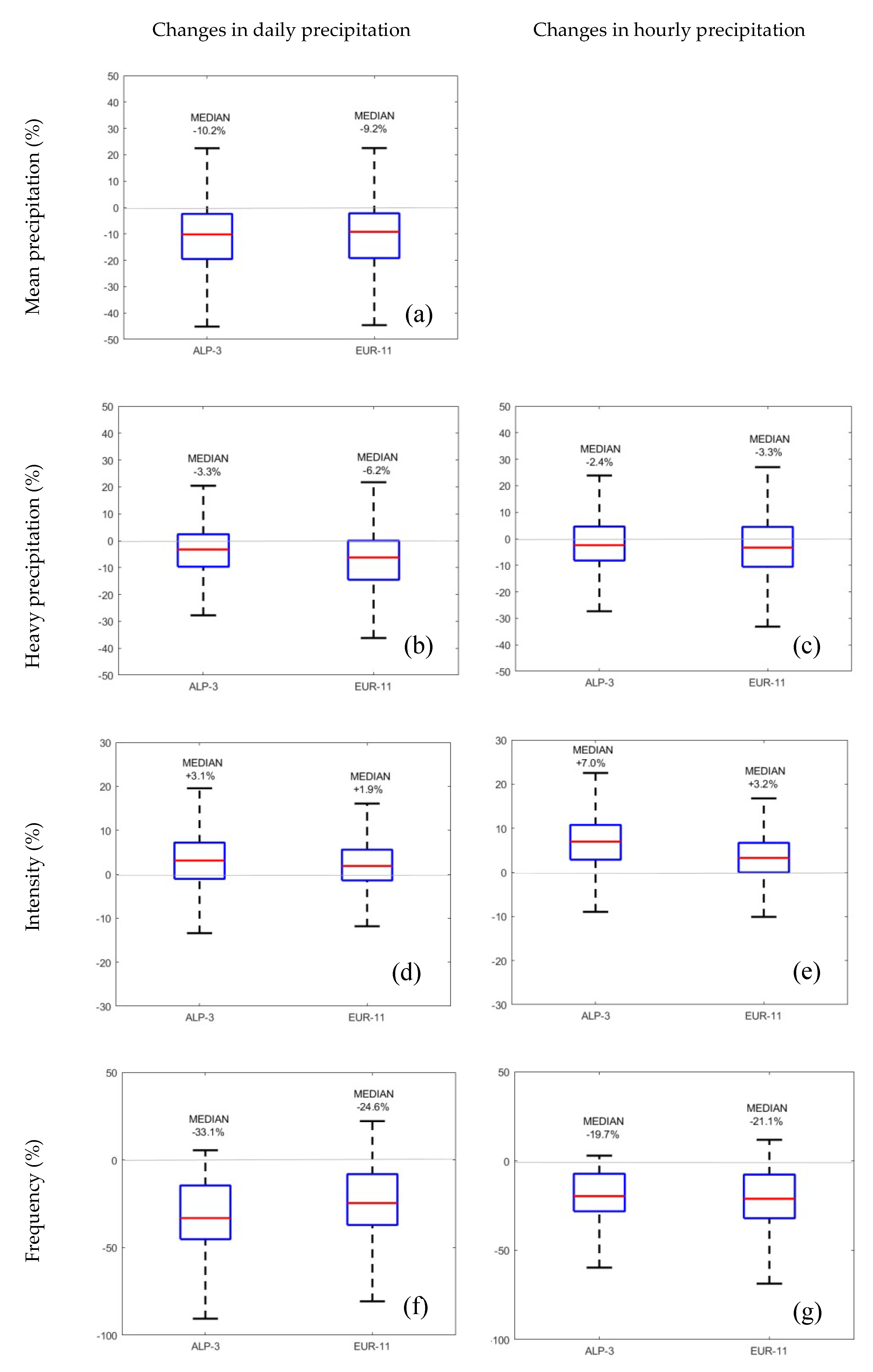
| Dataset | Grid Resolution | Time Resolution | Overlap Period | Reference |
|---|---|---|---|---|
| EURO4M-APGD | 5 km | daily | 2000–2008 | [46] |
| GRIPHO (IT) | 3 km | hourly | 2001–2005 | [47] |
| COMEPHORE (FR) | 1 km | hourly | 2001–2005 | [11,48] |
| Diagnostics | Unit | Description |
|---|---|---|
| Mean | (mm/d) | Mean precipitation |
| Frequency | (fraction) | Wet day/hour frequency * |
| Intensity | (mm/d)/(mm/h) | Wet day/hour intensity * |
| Heavy precipitation (99p/99.9p) | (mm/d)/(mm/h) | 99th/99.9th percentile of daily/hourly precipitation ** |
| Diagnostics | OBS | ALP-3 | EUR-11 |
|---|---|---|---|
| Mean precipitation (mm/d) | RMSE: - STD: 1.49 | RMSE: 0.48 STD: 1.92 | RMSE: 0.26 STD: 1.42 |
| Frequency (fraction) | RMSE: - STD: 0.12 | RMSE: 0.02 STD: 0.12 | RMSE: 0.03 STD: 0.13 |
| Intensity (mm/d) | RMSE: - STD: 1.98 | RMSE: 0.31 STD: 2.20 | RMSE: 0.34 STD: 1.68 |
| Heavy precipitation 99p (mm/d) | RMSE: - STD: 10.21 | RMSE: 2.43 STD: 11.57 | RMSE: 2.41 STD: 11.08 |
| Diagnostics | ALP-3 | EUR-11 |
|---|---|---|
| DAV | 3.14% | |
| ADKs | 30 | 180 |
| Diagnostics | OBS | ALP-3 | EUR-11 |
|---|---|---|---|
| Frequency (fraction) | RMSE: - STD: 0.03 | RMSE: 0.02 STD: 0.03 | RMSE: 0.08 STD: 0.01 |
| Intensity (mm/h) | RMSE: - STD: 0.27 | RMSE: 0.01 STD: 0.29 | RMSE: 0.12 STD: 0.20 |
| Heavy precipitation 99.9p (mm/h) | RMSE: - STD: 2.81 | RMSE: 0.11 STD: 2.75 | RMSE: 0.35 STD: 2.71 |
| Diagnostics | ALP-3 | EUR-11 |
|---|---|---|
| DAV | 129.5% | |
| ADKs | 126 | 3216 |
Publisher’s Note: MDPI stays neutral with regard to jurisdictional claims in published maps and institutional affiliations. |
© 2020 by the authors. Licensee MDPI, Basel, Switzerland. This article is an open access article distributed under the terms and conditions of the Creative Commons Attribution (CC BY) license (http://creativecommons.org/licenses/by/4.0/).
Share and Cite
Adinolfi, M.; Raffa, M.; Reder, A.; Mercogliano, P. Evaluation and Expected Changes of Summer Precipitation at Convection Permitting Scale with COSMO-CLM over Alpine Space. Atmosphere 2021, 12, 54. https://doi.org/10.3390/atmos12010054
Adinolfi M, Raffa M, Reder A, Mercogliano P. Evaluation and Expected Changes of Summer Precipitation at Convection Permitting Scale with COSMO-CLM over Alpine Space. Atmosphere. 2021; 12(1):54. https://doi.org/10.3390/atmos12010054
Chicago/Turabian StyleAdinolfi, Marianna, Mario Raffa, Alfredo Reder, and Paola Mercogliano. 2021. "Evaluation and Expected Changes of Summer Precipitation at Convection Permitting Scale with COSMO-CLM over Alpine Space" Atmosphere 12, no. 1: 54. https://doi.org/10.3390/atmos12010054
APA StyleAdinolfi, M., Raffa, M., Reder, A., & Mercogliano, P. (2021). Evaluation and Expected Changes of Summer Precipitation at Convection Permitting Scale with COSMO-CLM over Alpine Space. Atmosphere, 12(1), 54. https://doi.org/10.3390/atmos12010054







